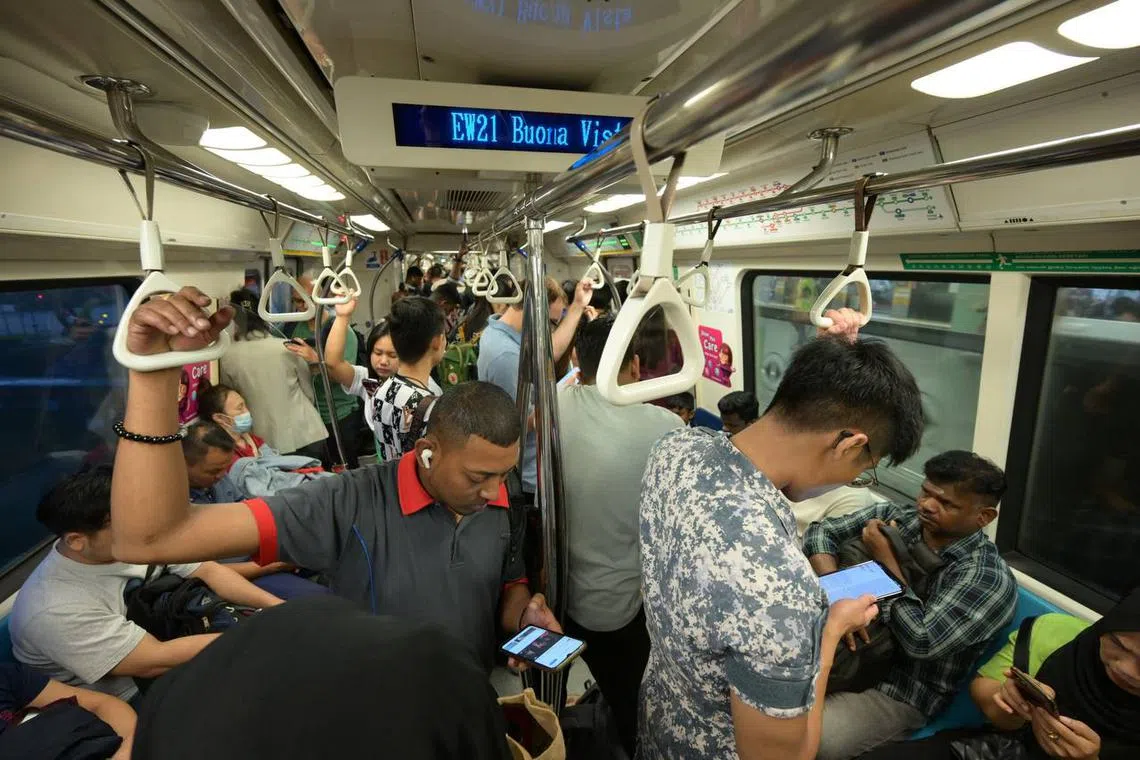East-West Line MRT services back to normal after 6-day disruption
Sign up now: Get ST's newsletters delivered to your inbox
Follow topic:
SINGAPORE – Train service resumed between Jurong East and Buona Vista MRT stations along the East-West Line on the morning of Oct 1
Commuters were glad to continue their commutes as usual, with some leaving home earlier to factor in the additional travelling time due to westbound trains running more slowly along the four-station stretch.
Westbound trains travelling on sections of repaired track, such as those between Dover and Clementi stations, will travel at a temporary speed limit of 40kmh till Oct 3 as part of a standard process after rail replacements. Trains typically move at speeds of between 60kmh and 80kmh.
Passengers heading westwards on the East-West Line have been advised to factor an extra five minutes into their travel time.
Student Seow Yi Xin, 16, was glad that her commuting time from Dover to Boon Lay was closer to the typical 45 minutes during regular service, compared with an hour and 15 minutes by bus for the past few days.
She added that it was fine that trains were moving more slowly. On Oct 1, she left home earlier to reach her school by 7.45am.
Ms Canmy Lim was relieved that she could travel eastwards from her home in Jurong East to her workplace in Buona Vista via the MRT “as per normal”.
The 42-year-old, who works in customer service, said it was “okay” that trains heading westwards were travelling more slowly, as long as services along the stretch were running.
The first eastbound train arrived at Jurong East station just after 5.40am. Signs that previously directed passengers to a temporary shuttle train service towards Boon Lay station had been removed.
Childcare centre cleaner Kavitha Simachallan, 44, said she was thankful to restart her usual commute from Jurong East to her workplace in Clementi, which is one stop away. She took a bridging bus between the two stops during the disruption.
To medical technologist Ong Shi Jie, the westbound trains were not moving significantly slower. The 35-year-old, who was travelling from her Bishan home to her office in Jurong East, said there was “not much of a difference” in waiting times.

Commuters on board the train travelling between Dover and Buona Vista MRT stations on Oct 1.
ST PHOTO: NG SOR LUAN
When train services on the East-West Line were partially down in the last few days, she took 1½ hours to get to work, taking a train first via the Circle Line to Buona Vista and then a bridging bus between Buona Vista and Jurong East. If train services were not disrupted, her commute would take about 40 minutes.
During lunchtime at Jurong East station, there was a small crowd of around 40 people waiting at the platforms.
SMRT staff member Jaleha Abu, 50, said she was pleasantly surprised when commuters thanked and cheered her on, adding that passengers were understanding and appreciative of what the staff were doing to ease the situation.
Services along the four-station stretch between Jurong East and Buona Vista were disrupted on Sept 25 when a faulty first-generation Kawasaki Heavy Industries train, which had been in service for more than 35 years, encountered a fault near Clementi station
As it was being withdrawn from service to Ulu Pandan Depot, a defective component on the train’s undercarriage – known as an axle box – dropped onto the tracks near Dover station.
This caused the wheels of the undercarriage to run off the rail. The severe damage triggered a power trip that stalled other trains and crippled rail services.
Among the equipment that was damaged were three point machines that divert trains onto different tracks, stretches of the third rail that supplies power to trains, and power cables.
Extensive repairs and replacement work had to be done, followed by tests of the track and trackside equipment
Beyond the affected four-station stretch, commuters travelling between Buona Vista and Queenstown stations, and between Jurong East and Boon Lay stations, experienced longer commute times for the past six days as shuttle trains there were operating at longer intervals of 10 minutes.
The disruption affected more than 2.1 million passengers from Sept 25 to 29. No figure for affected commuters was available for Sept 30, but it is likely to be in the hundreds of thousands.

